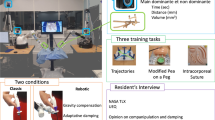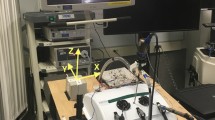Abstract
Purpose
The Johns Hopkins–Intuitive Gesture and Skill Assessment Working Set (JIGSAWS) dataset is used to develop robotic surgery skill assessment tools, but there has been no detailed analysis of this dataset. The aim of this study is to perform a learning curve analysis of the existing JIGSAWS dataset.
Methods
Five trials were performed in JIGSAWS by eight participants (four novices, two intermediates and two experts) for three exercises (suturing, knot-tying and needle passing). Global Rating Scores and time, path length and movements were analyzed quantitatively and qualitatively by graphical analysis.
Results
There are no significant differences in Global Rating Scale scores over time. Time in the suturing exercise and path length in needle passing had significant differences. Other kinematic parameters were not significantly different. Qualitative analysis shows a learning curve only for suturing. Cumulative sum analysis suggests completion of the learning curve for suturing by trial 4.
Conclusions
The existing JIGSAWS dataset does not show a quantitative learning curve for Global Rating Scale scores, or most kinematic parameters which may be due in part to the limited size of the dataset. Qualitative analysis shows a learning curve for suturing. Cumulative sum analysis suggests completion of the suturing learning curve by trial 4. An expanded dataset is needed to facilitate subset analyses.


Similar content being viewed by others
References
Martin JA, Regehr G, Reznick R, MacRae H, Murnaghan J, Hutchison C, Brown M (1997) Objective structured assessment of technical skill (OSATS) for surgical residents. Br J Surg 84:273–278
Goh AC, Goldfarb DW, Sander JC, Miles BJ, Dunkin B (2012) Global evaluative assessment of robotic skills: validation of a clinical assessment tool to measure robotic surgical skills. J Urol 187:247–252
van Hove PD, Tuijthof GJ, Verdaasdonk EG, Stassen LP, Dankelman J (2010) Objective assessment of technical surgical skills. Br J Surg 97:972–987
Mazzon G, Sridhar A, Busuttil G, Thompson J, Nathan S, Briggs T, Kelly J, Shaw G (2017) Learning curves for robotic surgery: a review of the recent literature. Curr Urol Rep 18(11):89
Uemura M, Tomikawa M, Kumashiro R, Miao T, Souzaki R, Ieiri S, Ohuchida K, Lefor AT, Hashizume M (2014) Analysis of hand motion differentiates expert and novice surgeons. J Surg Res 188:8–13
Uemura M, Tomikawa M, Miao T, Souzaki R, Ieiri S, Akahoshi T, Lefor AK, Hashizume M (2018) Feasibility of an AI-based measure of the hand motions of expert and novice surgeons. Comput Math Methods Med 2018:9873273
Dosis A, Bello F, Rockall T, Munz K, Moorthy S, Martin S and Darzi A. (2003) ROVIMAS: a software package for assessing surgical skills using the da Vinci telemanipulator system. The Fourth International Conference of Information Technology. (ITAB 2003) Birmingham, England
Dosis A, Aggarwal R, Bello F, Moorthy K, Munz Y, Gillies D, Darzi A (2005) Synchronized video and motion analysis for the assessment of procedures in the operating theater. Arch Surg 140:293–299
Mason JD, Ansell J, Warren N, Torkington J (2013) Is motion analysis a valid tool for assessing laparoscopic skill? Surg Endosc 27:1468–1477
Kowalewski KF, Garrow CR, Schmidt MW, Benner L, Müller-Stich BP, Nickel F (2019) Sensor-based machine learning for workflow detection and as key to detect expert level in laparoscopic suturing and knot-tying. Surg Endosc 33(11):3732–3740
Kowalewski KF, Hendrie JD, Schmidt MW, Garrow CR, Bruckner T, Proctor T, Paul S, Adigüzel D, Bodenstedt S, Erben A, Kenngott H, Erben Y, Speidel S, Müller-Stich BP, Nickel F (2017) Development and validation of a sensor- and expert model-based training system for laparoscopic surgery: the iSurgeon. Surg Endosc 31(5):2155–2165
Dosis A. (2005) Modeling and assessment of surgical dexterity in laparoscopic and robotically assisted surgery using synchronized video-motion analysis and hidden Markov models. Dissertation. Imperial College London, University of London
Aggarwal R, Grantcharov T, Moorthy K, Milland T, Papasavas P, Dosis A, Bello F, Darzi A (2007) An evaluation of the feasibility, validity, and reliability of laparoscopic skills assessment in the operating room. Ann Surg 245:992–999
DiMaio S and Hasser C. (2008) The da Vinci research interface. In 2008 MICCAI Workshop on Systems and Arch. For Computer Assisted Interventions, Midas Journal. http://hdl.handle.net/10380/1464
Hung AJ, Chen J, Jarc A, Hatcher D, Djaladat H, Gill IS (2018) Development and validation of objective performance metrics for robot-assisted radical prostatectomy: a pilot study. J Urol 199:296–304
Fard MJ, Ameri S, Darin Ellis R, Chinnam RB, Pandya AK, Klein MD (2018) Automated robot-assisted surgical skill evaluation: predictive analytics approach. Int J Med Robot 14:1–1850 (Epub 2017 Jun 29)
Judkins TN, Oleynikov D, Stergiou N (2009) Objective evaluation of expert and novice performance during robotic surgical training tasks. Surg Endosc 23:590–597
Gao Y, Vedula SS, Reiley CE, Ahmidi N, Varadarajan B, Liu H, Tao L, Zappella L, Bejar B, Yuh D, Chen CCG, Vidal R, Khudanpur S and Hager G. (2014) JHU-ISI gesture and skill assessment working set (JIGSAWS): a surgical activity dataset for human motion modeling. MICCAI Workshop 2014 M2CAI Vol 3
Forestier G, Petitjean F, Senin P, Despinoy F, Huaulmé A, Fawaz HI, Weber J, Idoumghar L, Muller PA, Jannin P (2018) Surgical motion analysis using discriminative interpretable patterns. Artif Intell Med 91:3–11
Ahmidi N, Tao L, Sefati S, Gao Y, Lea C, Haro BB, Zappella L, Khudanpur S, Vidal R, Hager GD (2017) A dataset and benchmarks for segmentation and recognition of gestures in robotic surgery. IEEE Trans Biomed Eng 64:2025–2041
Funke I, Mees ST, Weitz J, Speidel S (2019) Video-based surgical skill assessment using 3D convolutional neural networks. Int J Comput Assist Radiol Surg 14:1217–1225
Zia A, Essa I (2018) Automated surgical skill assessment in RMIS training. Int J Comput Assist Radiol Surg 13:731–739
Wang Z, Majewicz FA (2018) Deep learning with convolutional neural network for objective skill evaluation in robot-assisted surgery. Int J Comput Assist Radiol Surg 13:1959–1970
Ismail Fawaz H, Forestier G, Weber J, Idoumghar L, Muller PA (2019) Accurate and interpretable evaluation of surgical skills from kinematic data using fully convolutional neural networks. Int J Comput Assist Radiol Surg 14:1611–1617
Nguyen XA, Ljuhar D, Pacilli M, Nataraja RM, Chauhan S (2019) Surgical skill levels: classification and analysis using deep neural network model and motion signals. Comput Methods Programs Biomed 2019(177):1–8
Anh NX, Nataraja RM, Chauhan S (2020) Towards near real-time assessment of surgical skills: a comparison of feature extraction techniques. Comput Methods Programs Biomed 187:105234. https://doi.org/10.1016/j.cmpb.2019.105234 (PMID: 31794913)
Sorensen MD, Delostrinos C, Johnson MH, Grady RW, Lendvay TS (2011) Comparison of the learning curve and outcomes of robotic assisted pediatric pyeloplasty. J Urol 185(6 Suppl):2517–2522
Woelk JL, Casiano ER, Weaver AL, Gostout BS, Trabuco EC, Gebhart JB (2013) The learning curve of robotic hysterectomy. Obstet Gynecol 121:87–95
Vilallonga R, Fort JM, Gonzalez O, Caubet E, Boleko A, Neff KJ, Armengol M (2012) The initial learning curve for robot-assisted sleeve gastrectomy: a surgeon’s experience while introducing the robotic technology in a bariatric surgery department. Minim Invasive Surg 2012:347131
Hernandez JD, Bann SD, Munz Y, Moorthy K, Datta V, Martin S, Dosis A, Bello F, Darzi A, Rockall T (2004) Qualitative and quantitative analysis of the learning curve of a simulated surgical task on the da Vinci system. Surg Endosc 18:372–378
Leijte E, de Blaauw I, Van Workum F, Rosman C, Botden S (2020) Robot assisted versus laparoscopic suturing learning curve in a simulated setting. Surg Endosc 34(8):3679–3689
Duran C, Estrada S, O’Malley M, Lumsden AB, Bismuth J (2015) Kinematics effectively delineate accomplished users of endovascular robotics with a physical training model. J Vasc Surg 61:535–541
Bustos R, Mangano A, Gheza F, Chen L, Aguiluz-Cornejo G, Gangemi A, Sanchez-Johnsen L, Hassan C, Masrur M (2019) Robotic-assisted Roux-en-Y Gastric bypass: learning curve assessment using cumulative sum and literature review. Bariatr Surg Pract Patient Care 14:95–101
Waller HM, Connor SJ (2009) Cumulative sum (Cusum) analysis provides an objective measure of competency during training in endoscopic retrograde cholangio-pancreatography (ERCP). HPB (Oxford) 11:565–569
Weil G, Motamed C, Biau DJ, Guye ML (2017) Learning curves for three specific procedures by anesthesiology residents using the learning curve cumulative sum (LC-CUSUM) test. Korean J Anesthesiol 70:196–202
Wani S, Coté GA, Keswani R, Mullady D, Azar R, Murad F, Edmundowicz S, Komanduri S, McHenry L, Al-Haddad MA, Hall M, Hovis CE, Hollander TG, Early D (2013) Learning curves for EUS by using cumulative sum analysis: implications for American society for gastrointestinal endoscopy recommendations for training. Gastrointest Endosc 77:558–565
Lefor AL, Harada K, Dosis A, Mitsuishi M (2020) Motion analysis of the JHU-ISI gesture and skill assessment working set using robotics video and motion assessment software. Int J Comput Assist Radiol Surg 15(12):2017–2025
Datta V, Chang A, Mackay S, Darzi A (2002) The relationship between motion analysis and surgical technical assessments. Am J Surg 184:70–73
JIGSAWS: The JHU-ISI Gesture and Skill Assessment Working Set. Accessed 2019–07–10. https://cirl.lcsr.jhu.edu/research/hmm/datasets/jigsaws_release
Nisky I, Okamura AM, Hsieh MH (2014) Effects of robotic manipulators on movements of novices and surgeons. Surg Endosc 28:2145–2158
Wilcoxon signed-ranks test calculator, https://www.socscistatistics.com/tests/signedranks/default.aspx, accessed 27 December 2020
Hung AJ, Chen J, Gill IS (2018) Automated performance metrics and machine learning algorithms to measure surgeon performance and anticipate clinical outcomes in robotic surgery. JAMA Surg 153(8):770–771. https://doi.org/10.1001/jamasurg.2018.1512 (PMID: 29926095)
Hung AJ, Oh PJ, Chen J, Ghodoussipour S, Lane C, Jarc A, Gill IS (2019) Experts vs super-experts: differences in automated performance metrics and clinical outcomes for robot-assisted radical prostatectomy. BJU Int 123(5):861–868. https://doi.org/10.1111/bju.14599 (PMID: 30358042)
Acknowledgement
The contributions of Murilo Marinho PhD are gratefully acknowledged.
Funding
This work was supported by JSPS KAKENHI Grant Number 19H05585.
Author information
Authors and Affiliations
Corresponding author
Ethics declarations
Conflict of interest
The authors declare that they have no conflict of interest.
Ethical approval
This study did not involve any human or animal subjects. There is no informed consent. This is a review of published data.
Data availability
All data are available online [38].
Code availability
The software used to convert data from the JIGSAWS data to the format used by ROVIMAS is available on request from the author.
Informed consent
Informed consent was obtained from all individual participants included in the study.
Additional information
Publisher's Note
Springer Nature remains neutral with regard to jurisdictional claims in published maps and institutional affiliations.
Rights and permissions
About this article
Cite this article
Lefor, A.K., Harada, K., Dosis, A. et al. Motion analysis of the JHU–ISI Gesture and Skill Assessment Working Set II: learning curve analysis. Int J CARS 16, 589–595 (2021). https://doi.org/10.1007/s11548-021-02339-8
Received:
Accepted:
Published:
Issue Date:
DOI: https://doi.org/10.1007/s11548-021-02339-8




